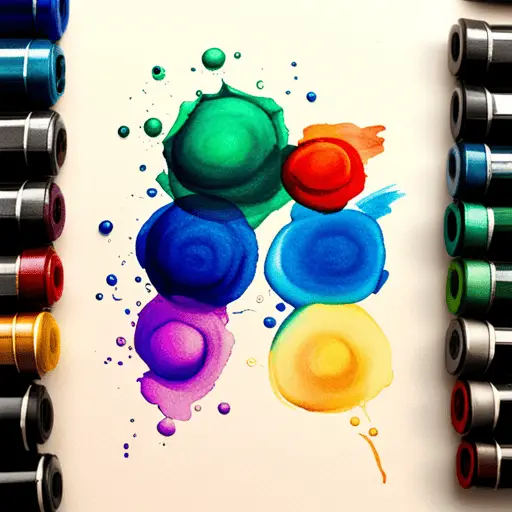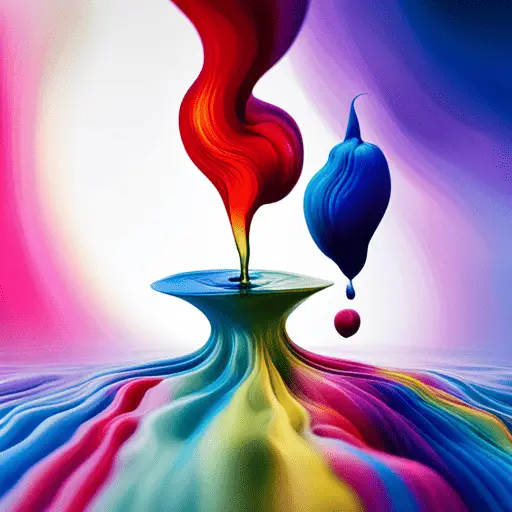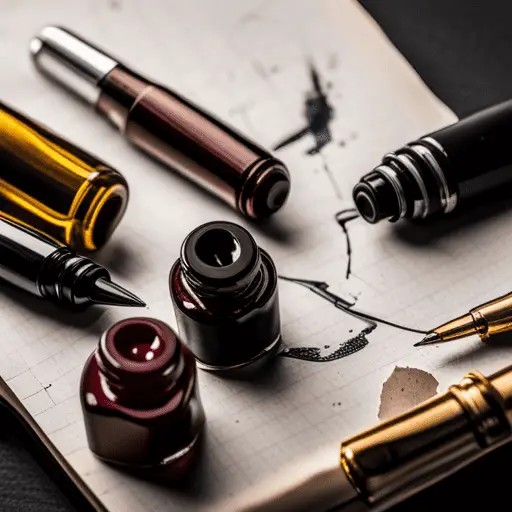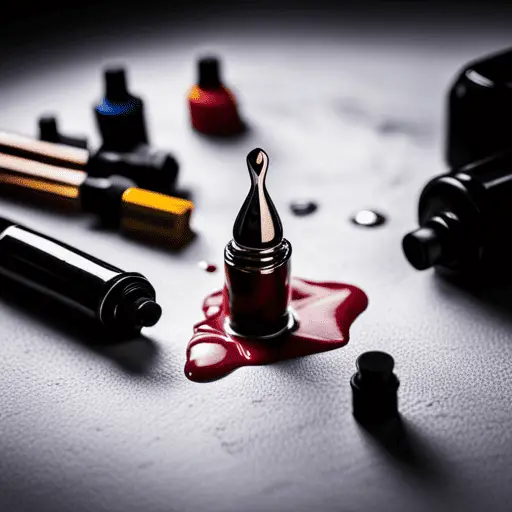Are you tired of using the same old boring ballpoint pens? Do you crave a writing experience that is both elegant and unique? Look no further than the world of fountain pens.
But with so many different types of fountain pen ink available, it can be overwhelming to choose the right one for your needs. That’s where this comprehensive guide comes in, helping you decode the different types of fountain pen ink and choose the perfect one for your writing style.
Fountain pen ink is not just any ordinary ink. It is specially formulated to flow smoothly through the nib of a fountain pen, creating a unique writing experience that cannot be replicated with any other writing instrument.
But not all fountain pen inks are created equal. Some are more vibrant, some are more water-resistant, and some are more suitable for certain types of paper. By understanding the properties of different types of fountain pen ink, you can choose the one that best suits your needs and preferences.
So let’s dive in and explore the world of fountain pen ink together.
Key Takeaways
– There are different types of fountain pen ink available including dye-based ink, pigment-based ink, and iron gall ink, each with their own composition and benefits.
– Properties of fountain pen ink such as drying time, water resistance, and color saturation are important considerations when choosing the right ink for your needs.
– Care and maintenance of fountain pens and ink is crucial for a good writing experience and includes proper preparation, storage, and troubleshooting techniques for common ink problems.
– Choosing the right ink for your writing style and preferences is crucial to enhancing the writing experience and expressing creativity.
Types of Fountain Pen Ink

You may be wondering about the different types of fountain pen ink available on the market. Dye-based ink is the most common type and is known for its vibrant colors and quick drying time.
On the other hand, pigment-based ink is more resistant to water and fading. Lastly, iron gall ink is a traditional type of ink that’s known for its unique properties and historic use.
So, if you’re looking for a specific type of fountain pen ink, make sure to consider these options and choose the one that best fits your needs.
Dye-Based Ink
Get ready to experience the vibrant colors and smooth flow of dye-based ink in your fountain pen! This type of ink is composed of water-soluble dyes, which allows for a wider range of color options than other types of ink.
The ink flow is also consistent and smooth, making it a great choice for everyday writing. Here are three reasons why you’ll love dye-based ink in your fountain pen:
– EXPRESSION: With a range of bright and bold colors, dye-based ink allows you to express yourself in a unique way. Whether you’re writing a letter or journaling, the colors will pop off the page and make your words stand out.
– CONSISTENCY: The ink flow of dye-based ink is consistent and reliable, ensuring that your writing experience is smooth and effortless. No more worrying about ink skipping or drying out in your pen.
– VERSATILITY: Dye-based ink is compatible with a wide range of fountain pens, so you can experiment with different pens to find the perfect match for your writing style. Plus, it’s easy to clean out of your pen when it’s time to switch colors.
Pigment-Based Ink
Now it’s time to discover the unique qualities of pigment-based ink in your writing tool. Unlike dye-based ink, pigment-based ink contains solid pigment particles that do not dissolve in water. These particles are suspended in a liquid solution, which ensures that the ink composition is stable and long-lasting.
One of the most significant benefits of pigment-based ink is its lightfastness, which is the ability to resist fading when exposed to light or heat. This means that the color vibrancy of pigment-based ink remains intact even after years of use, making it an ideal choice for documents that require archival quality. The table below summarizes the differences between dye-based ink and pigment-based ink, highlighting the superior qualities of the latter.
| Ink Type | Composition | Color Vibrancy | Lightfastness | Archival Quality |
|---|---|---|---|---|
| Dye-Based Ink | Water-soluble dyes | Good | Poor | No |
| Pigment-Based Ink | Solid pigment particles suspended in liquid | Excellent | Excellent | Yes |
So, if you want to ensure that your writing withstands the test of time, consider using pigment-based ink in your fountain pen. Not only will it provide vibrant colors, but it will also give you the assurance that your writing will remain legible and intact for years to come.
Iron Gall Ink
Congratulations, you’ve stumbled upon the ink world’s best-kept secret: the infamous iron gall ink. This type of ink has been used for centuries and was widely popular during the Middle Ages. Its unique composition consists of tannic acid and iron salts, which create a chemical reaction that produces a dark, permanent ink that is resistant to fading and water damage.
Iron gall ink has significant historical significance as it was the ink of choice for many famous writers and artists such as Leonardo da Vinci and Shakespeare. However, due to its acidic nature, iron gall ink can corrode paper over time, causing it to become brittle and disintegrate.
Therefore, it is recommended to use this type of ink only on archival-quality paper or for short-term use. Overall, if you’re looking for a classic, long-lasting ink that is steeped in history, iron gall ink is definitely worth a try.
Properties of Fountain Pen Ink

When it comes to fountain pen ink, you want to know about its properties. You’re curious about how long it takes to dry, how water-resistant it is, and how intense the colors are.
Well, the drying time can vary depending on the paper, but generally, it takes a few seconds to a few minutes. Water resistance is important because you don’t want your writing to smudge or run if it gets wet. As for color saturation, some inks are more vibrant than others, so it’s important to choose one that suits your taste.
Drying Time
One key aspect of using fountain pens is understanding the varying drying times of different ink types. Some inks dry quickly, while others take a bit longer to set. Factors affecting drying time include the type of ink, the paper quality, and the humidity of the environment.
It’s important to take note of these factors when choosing an ink to use with your fountain pen. To ensure that your ink dries properly and doesn’t smudge, it’s important to use high-quality paper that is specifically designed for use with fountain pens. This will help prevent the ink from bleeding and will allow it to dry more quickly.
Additionally, it’s important to consider the humidity of the environment you’re writing in, as high levels of humidity can cause your ink to take longer to dry. By taking these factors into consideration and choosing the right ink and paper for your needs, you can ensure that your fountain pen writing experience is as smooth and enjoyable as possible.
Water Resistance
Don’t be caught in the rain without water-resistant ink in your fountain pen! Waterproof fountain pen ink is an essential element to consider when choosing your writing tool. Water resistance is essential in different situations, and it can be a lifesaver, especially when document preservation is required.
Waterproof fountain pen ink is ideal for individuals who are always on the go or those who live in areas with high humidity. This ink type is designed to resist water, which means that it won’t smudge or blur when exposed to moisture. It is perfect for those who love outdoor activities such as hiking, camping, or fishing, as it allows you to take notes without worrying about the weather.
Additionally, water-resistant ink is essential for legal documents, contracts, and any paperwork that must be preserved for a long time. By using waterproof fountain pen ink, you can ensure that your writing won’t fade or disappear, even if it gets wet.
Color Saturation
You’ll love the vibrant colors that come with high color saturation in fountain pen ink. The ink flow is smooth and consistent, resulting in a rich and bold hue on the page.
Whether you’re writing a letter, journaling, or doodling, the color vibrancy of high saturation ink will add an extra pop to your creative endeavors.
Not only do high saturation inks offer a visually appealing experience, but they also have practical benefits. The boldness of the ink makes it easier to read, and the consistent flow ensures a clean and crisp line.
So, if you’re looking to add some excitement to your writing, consider trying out a high saturation fountain pen ink. Your words will never be boring again.
Choosing the Right Fountain Pen Ink

Picking the perfect fountain pen ink requires proper preparation and a penchant for precision.
First and foremost, you need to consider the ink composition. Different ink types have unique characteristics that affect the ink flow, drying time, and color saturation. For instance, dye-based inks produce vivid and intense colors but tend to bleed through thin paper. On the other hand, pigment-based inks are more stable and resistant to water and light but may require a longer drying time.
Aside from ink composition, your personal preference should also influence your ink selection. Do you prefer bold and bright colors or subtle and understated hues? Do you often write on specific paper types or surfaces that require a particular ink type?
These are just some of the questions you need to ask yourself when choosing the right fountain pen ink. Remember, the right ink not only enhances your writing experience but also complements your unique style and personality.
Care and Maintenance of Fountain Pen Ink

Proper care and maintenance is crucial for ensuring the longevity of your fountain pen and the quality of your writing experience, so it’s important to regularly clean and refill your pen with ink. Here are some tips to help you take care of your fountain pen ink:
– Cleaning tips: Use a bulb syringe to flush out the old ink from your pen. You can also soak the nib and feed section in warm water and gently scrub with a soft toothbrush. Make sure to dry your pen thoroughly before refilling it with ink.
– Ink storage: Keep your ink bottles tightly closed and store them in a cool, dry place away from direct sunlight. This will prevent the ink from evaporating or becoming contaminated. Also, try to use up your ink within a reasonable time frame to avoid any potential quality issues.
By following these simple tips, you can ensure that your fountain pen and ink last longer and maintain their quality. Don’t forget to enjoy the writing experience and try out different ink colors to express your creativity!
Troubleshooting Fountain Pen Ink Issues

If you encounter any issues with your fountain pen ink, don’t panic! There are simple troubleshooting techniques that you can use to address common ink problems. The first step is to identify the issue. Is your ink flow inconsistent? Is your ink smudging or bleeding? Once you’ve identified the problem, it’s time to take action.
One common ink problem is clogging. This occurs when the ink dries and blocks the flow of ink from the pen. To solve this issue, you can try cleaning techniques like soaking your pen nib in warm water or using a cleaning solution specifically designed for fountain pens. Another issue is feathering, which is when the ink spreads out and creates a feathery effect on the paper. This can be solved by using a higher quality paper or a different ink formula. By taking these simple steps, you can troubleshoot and solve any issues you may encounter with your fountain pen ink.
| Common Ink Problems | Cleaning Techniques | ||
|---|---|---|---|
| Ink flow inconsistency | Check nib alignment, clean nib/feed, flush pen with water | ||
| Feathering | Use higher quality paper, try a different ink formula | ||
| Clogging | Soak nib in warm water, use cleaning solution specifically designed for fountain pens | Scratches or damage to the nib | Avoid using abrasive materials or dropping the pen, consider getting the nib professionally repaired or replaced |
Conclusion
Congrats! You’ve just unlocked the world of fountain pen inks! With a variety of options available, it can be overwhelming to choose the right ink for your pen. But now that you have a better understanding of the different properties of inks, you’ll be able to make an informed decision.
Did you know that fountain pen ink manufacturers produce over 500 different colors? That’s right! With so many options, you can truly express your style and personality through your writing.
Plus, fountain pen ink is typically more vibrant and saturated than other types of ink, making your writing stand out even more.
Remember, it’s important to choose the right ink for your pen to ensure a smooth writing experience and avoid any potential issues. With proper care and maintenance, your fountain pen and ink can last for years to come.
So go ahead and try out a new ink color, and let your creativity flow!
